
The Norton Motorcycle Company is a brand of motorcycles headquartered in Solihull, West Midlands,, England. For some years around 1990, the rights to use the name on motorcycles were owned by North American financiers.

The Norton Commando is a British Norton-Villiers motorcycle with an OHV pre-unit parallel-twin engine, produced by the Norton Motorcycle company from 1967 until 1977. Initially having a nominal 750 cc displacement, actually 745 cc (45.5 cu in), in 1973 it became an 850 cc, actually 828 cc (50.5 cu in). It had a hemi-type head, similar to all OHV Norton engines since the early 1920s.
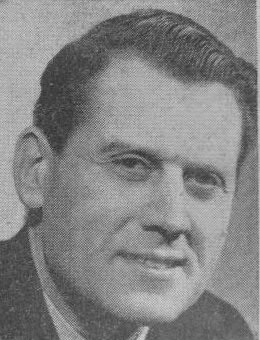
Douglas Lionel Hele was a pioneering British motorcycle engineer with Triumph and other firms: BSA, Douglas and Norton. He was born in Birmingham in 1919 and died in Hagley, Worcestershire on 2 November 2001.

The Norton ES2 is a Norton motorcycle produced from 1927 until 1964. From 1965, a different machine was produced for a short time by parent manufacturer AMC, based on a Matchless but badged as Norton ES2 Mk2.
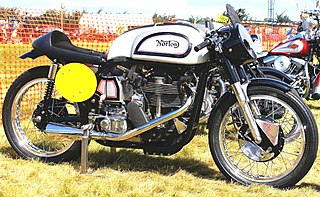
The Norton Manx or Manx Norton is a British racing motorcycle that was made from 1947 to 1962 by Norton Motors Ltd. Norton had contested every Isle of Man TT race from the inaugural 1907 event through into the 1970s, a feat unrivalled by any other manufacturer, and the development and honing of the Manx racing motorcycle was another step in this racing achievement.
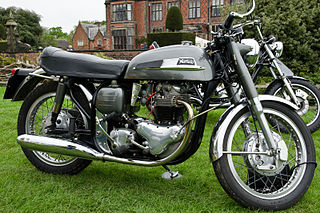
The Dominator is a twin cylinder motorcycle developed by Norton to compete against the Triumph Speed Twin. The original Dominator was designed in 1947 and 1948 by Bert Hopwood, who had been on the Speed Twin design team at Triumph. Available for sale from mid 1949, this design set the pattern for Norton twins for the next 30 years.

The Norton Atlas was a Norton motorcycle made between 1962 and 1968, until it was replaced by the Norton Commando.

The Norton International or Cammy Norton is a Norton Motors Ltd overhead cam (OHC) motorcycle built between 1931 and 1957.

The featherbed frame was a motorcycle frame invented by the McCandless brothers and offered to the British Norton motorcycle company to improve the performance of their racing motorcycles in 1950. It was considered revolutionary at the time, and the best handling frame that a racer could have. Later adopted for Norton production motorcycles, it was also widely used by builders of custom hybrids such as the Triton, becoming legendary and remaining influential to this day.

The Jubilee is a Norton motorcycle made from 1958 to 1966. Named to commemorate Norton's Diamond Jubilee, the 249 cc Jubilee was a break with Norton tradition designed in response to UK legislation introduced in 1960 limiting learner riders to motorcycles of under 250 cc. It had the smallest engine ever made by Norton, and was the first Norton with a unit construction engine and gearbox.
The Navigator is a Norton motorcycle made from 1960 to 1965, based on the Norton Jubilee 250 cc. Production ceased shortly before the collapse of the parent group Associated Motor Cycles in 1966.

The Dunstall Norton was a Norton motorcycle made by Paul Dunstall, a specialist tuner of the 1960s and early 1970s twins originally using some parts from Norton's Domiracer project when the Birmingham factory was closed in 1963. In 1966 Dunstall Motorcycles became a motorcycle manufacturer in its own right so that Dunstalls could compete in production races, and set a number of world records before sales of the Dunstall Nortons declined in the 1970s consistent with the demise of the British motor cycle industry and a corresponding rise in Japanese imports.
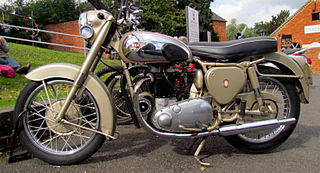
The BSA A10 series was a range of 646 cc (39.4 cu in) air-cooled parallel twin motorcycles designed by Bert Hopwood and produced by Birmingham Small Arms Company at Small Heath, Birmingham from 1950 to 1963. The series was succeeded by the A65 unit construction models.

The Norton Commando Production Racer was a hand built production racer produced by Norton-Villiers from 1970 - 1972. It was based on the road-going Norton Commando, and although fitted with lights it was never intended as a road bike. The model was commonly known as the Yellow Peril.
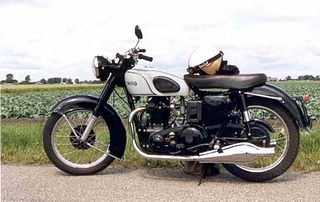
The Norton Model 7 Dominator was a 500 cc vertical twin motorcycle manufactured by the Norton Motorcycle Company from 1949 to 1955. It was the first of Norton's Dominator range of motorcycles. The engine was designed by Bert Hopwood and was a departure from Norton's previous practice of producing single-cylinder machines. The Model 7 was used in Japan as a police motorcycle.
The 1st Norton Model 77 Dominator was a 500 cc all iron vertical twin rigid framed Norton motorcycle manufactured by Norton Motors Ltd from 1950 to 1952. All 237 examples were exported to Australia. Very little publicity surrounded this model - so much so that it was denied that they existed for some decades. It is possible that they were intended to be sidecar haulers, but the stock Model 7 - with the identical all iron engine- was equipped with sidecar mounting points, so this aspect is still a matter of discussion.

The Norton Model 99 Dominator was a 600 cc vertical twin motorcycle manufactured by the British Norton Motorcycle Company at their Bracebridge St, Birmingham factory from 1956 to 1962. The 99 was based on the 500 cc Model 88 Dominator with an enlarged engine. The model was superseded by the 650SS.
The Norton Manxman was a 650 cc vertical twin motorcycle manufactured by the British Norton Motorcycle Company at their Bracebridge St, Birmingham factory for export. The engine was an enlargement of the 600 cc engine used in the Model 99 Dominator. The Manxman was first shown at the November 1960 Earls Court Motorcycle Show and listed by the American importer, Berliner, in their catalogue from 1961 to October 1962 Berliner had asked for the model to be named Manxman although the twin had never been raced at the Isle of Man.

The Norton 650 Dominator was a 650 cc vertical twin motorcycle manufactured by the British Norton Motorcycle Company from 1962 to 1967. Initially production was at Norton's Bracebridge St, Birmingham factory, but following the factory's closure in 1963, production was transferred to parent company AMC's works in Plumstead, London. Initially produced in single and twin carburettor versions, the single carb version was soon discontinued. The twin carb version, the 650SS, was described as the 'Best of the Dominators'.

The Norton Mercury was a 646 cc (39.4 cu in) air-cooled OHV parallel twin motorcycle made by Norton-Villiers from 1968 to 1970. It was the last Norton model to use the 'featherbed' frame. Following the collapse of AMC and the subsequent formation of Norton Villiers, the company's focus had been on the new Norton Commando. There was a large inventory of parts from previous models that would not be used on the Commando, and to use up this stock the Mercury was conceived. The Mercury was introduced in October 1968 and around 750 machines were produced, most of the production going to the US. The model was also used by the Nigerian Police.
















